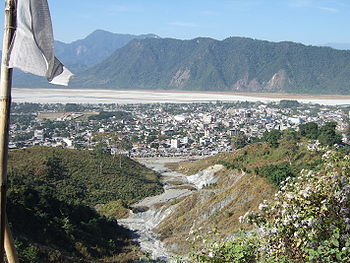|
Chukha District
27°0′N 89°30′E / 27.000°N 89.500°E
  Chukha District (Dzongkha: ཆུ་ཁ་རྫོང་ཁག་; Wylie: Chu-kha rdzong-khag; officially spelled "Chhukha" [2]) is one of the 20 dzongkhag (districts) comprising Bhutan. The major town is Phuentsholing. LanguagesIn Chukha, the main native languages are Dzongkha, the national language, and Nepali, spoken by the Lhotshampa in the south. The Bhutanese Lhokpu language, spoken by the Lhop minority, is also present in the southwest along the border with Samtse District. Administrative divisionsChukha District is divided into eleven village blocks (or gewogs):[3] EnvironmentChukha Dzongkhag covers 1,880 sq. km,[4] but unlike most other districts, Chukha, along with Samtse, contain no protected areas of Bhutan. Although much of southern Bhutan contained protected areas in the 1960s, park-level environmental protection became untenable.[5][6] InfrastructureChukha contains Bhutan's oldest hydropower plant, Chukha hydel (completed in 1986–88), and Tala Hydroelectricity Project, the country's largest power plant. TourismDokhachu Goenpa Dokhachu Goenpa, also known as Ekajati Lhakhang, is a Buddhist temple located in Chapcha, Bhutan. It was founded in 1650 by Choeje Thinley Jamtsho. The Monastery houses a revered statue of the wish-granting goddess Ekajati, or Aum Kangchim, believed to fulfill devotees' wishes.[7] Tumdra Aminey Tumdra Ami Ney is a chief abode of wish-granting goddess Lhamo Ekajati located in Darla Gewog under Chhukha Dzongkhag in Bhutan. The Ney was discovered by Thangthong Gyalpo, and later Terton Drukdra Dorji meditated and discovered “Ter” of Aum Kangchim Statue from the Ney in the eighteenth century.[8][9] Geling Goenpa Thadra Goenpa See alsoReferences
External links
|
||||||||||||||||||||||||||||||

